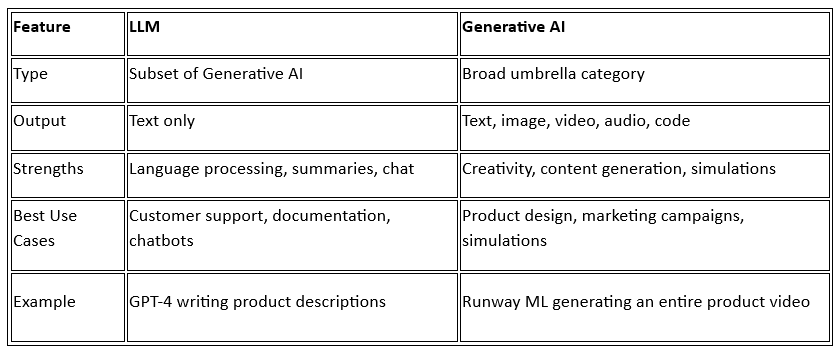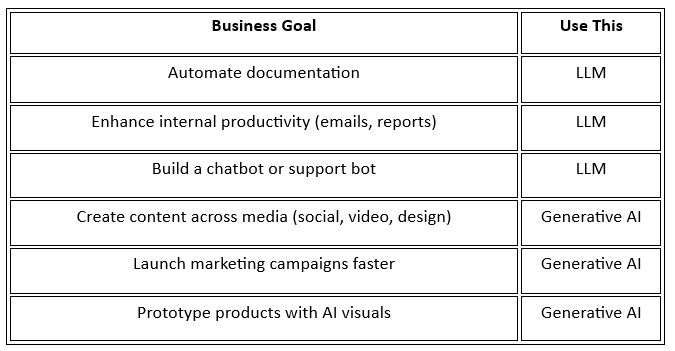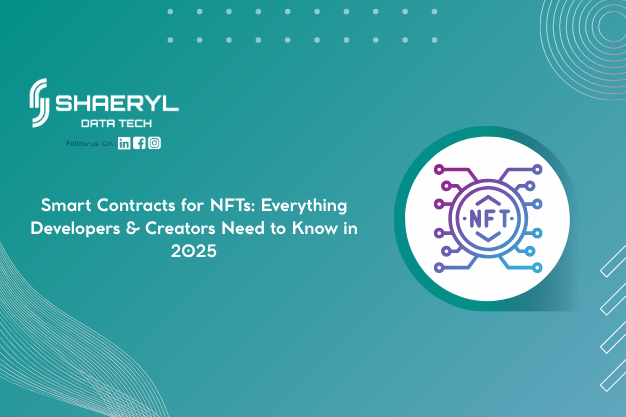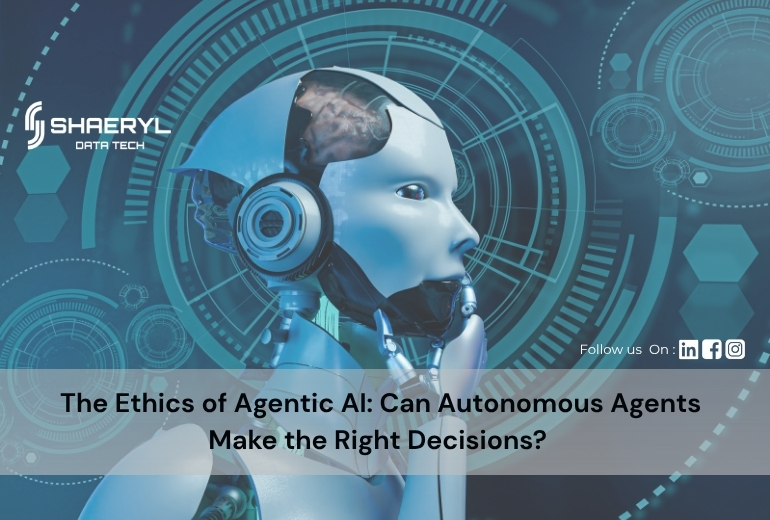Everyone’s talking about Generative AI and Large Language Models (LLMs). They’re in boardroom presentations, startup pitches, social media posts — and probably your inbox too. But let’s be honest — most explanations are either too technical or too vague.
Here’s the reality: LLMs are a type of Generative AI, but Generative AI is much broader.
In this blog, we’ll ditch the jargon and explain both using simple analogies, clear comparisons, and real-world use cases. Whether you’re a business leader, developer, or curious marketer, this guide will help you understand what these technologies really are — and how to use them to generate business value.
In the rapidly evolving landscape of artificial intelligence, the terms “Generative AI” and “Large Language Models (LLMs)” are often used interchangeably, creating a vortex of confusion for business leaders and marketers. While both are groundbreaking technologies with the potential to revolutionize industries, understanding their distinct roles is crucial for harnessing their true power. This guide will demystify these concepts using simple analogies, explore their capabilities beyond the hype, and demonstrate how a clear understanding can become a cornerstone of your lead-generation strategy.
The distinction is more than just semantics; it’s about identifying the right tool for the right job. Think of it this way: would you use a master chef’s entire kitchen to simply boil an egg? Probably not. Similarly, knowing when you need the broad creative power of generative AI versus the specialized linguistic prowess of an LLM can save you time, resources, and ultimately, drive better business outcomes.
What Are We Talking About? Definitions Made Simple
Large Language Models (LLMs)
LLMs are machine learning models trained on huge volumes of text to understand, generate, and respond using natural language.
Think of it as:
A super-intelligent autocomplete that can write essays, answer questions, summarise reports, or even generate code.
Popular LLMs: ChatGPT (OpenAI), Claude (Anthropic), Gemini (Google), LLaMA (Meta)
Generative AI
Generative AI is a broader category of AI that creates new content — not just text, but also images, audio, video, and code.
Think of it as:
An AI artist, writer, composer, and developer all rolled into one. It’s capable of producing original outputs from scratch.
Popular Generative AI Tools:
DALL·E (image), Midjourney (art), Synthesia (video), Runway ML (film), Sora (video), GitHub Copilot (code)
Generative AI: The Master Artist and Innovator
At its core, Generative AI is a broad category of artificial intelligence that can create new and original content. It’s not just about regurgitating existing data; it’s about synthesizing that data to produce something entirely novel. This content can take many forms, including images, music, code, and of course, text.
A helpful analogy for generative AI is that of a master artist. This artist has spent years studying various art forms, techniques, and historical periods. They can create a photorealistic portrait, a surrealist landscape, or a classical symphony. Their ability isn’t limited to one style or medium; they can generate a wide array of original works based on their vast knowledge and a specific prompt.
Beyond Text: The Diverse Palette of Generative AI
While text generation is a prominent application, the capabilities of generative AI extend far beyond the written word. Here are some examples of generative AI that are not exclusively reliant on LLMs:
- Image Generation: Tools like DALL-E 2 and Midjourney can create stunningly realistic or artistically stylized images from simple text descriptions. For businesses, this can mean generating unique marketing collateral, product mockups, or website graphics without the need for a graphic designer.
- Music Composition: AI-powered music generators can compose original scores in various genres, from classical to electronic. This can be a game-changer for content creators, filmmakers, and advertisers who need royalty-free background music.
- Code Generation: Generative AI models can write code in multiple programming languages, assisting developers in building applications, debugging, and automating repetitive coding tasks. This accelerates the development lifecycle and frees up developers to focus on more complex problem-solving.
- Drug Discovery and Design: In the scientific realm, generative AI is being used to design new molecules and proteins, potentially leading to the development of novel drugs and therapies at an unprecedented speed.
These examples highlight the versatility of generative AI. It’s a powerful engine of creation, capable of innovating across a multitude of domains.
Large Language Models (LLMs): The Eloquent Wordsmith
Now, let’s zoom in on a specific, yet incredibly powerful, subset of generative AI: Large Language Models (LLMs). As the name suggests, LLMs are specialized in understanding and generating human-like text. They are trained on colossal amounts of text data, enabling them to grasp the nuances of grammar, context, and style.
A fitting analogy for an LLM is an eloquent and knowledgeable wordsmith or a highly skilled librarian. This individual has read virtually every book, article, and website in existence. They can answer your questions with remarkable accuracy, summarize lengthy documents in seconds, translate languages fluently, and even write poetry or prose in the style of a famous author. Their expertise is deeply rooted in the world of language.
The Power of Language: Where LLMs Excel
LLMs are the driving force behind many of the AI applications we interact with daily. Their capabilities include:
- Content Creation: From blog posts and articles to emails and social media updates, LLMs can generate high-quality written content on a vast range of topics.
- Chatbots and Virtual Assistants: The natural and engaging conversations you have with advanced chatbots are powered by LLMs. They can understand your intent, provide relevant information, and even offer personalized recommendations.
- Summarization and Analysis: LLMs can quickly distill the key points from long reports, articles, or transcripts, saving you valuable time and effort.
- Translation: With their deep understanding of multiple languages, LLMs can provide accurate and context-aware translations.
It’s important to remember that while all LLMs are a form of generative AI, not all generative AI is an LLM. The master artist can write a beautiful poem (a linguistic task), but their skillset extends to painting and sculpting as well. Similarly, generative AI’s creative potential goes beyond the mastery of language that defines LLMs.
The Symbiotic Relationship: How They Work Together
The lines between generative AI and LLMs can blur because they often work in tandem. An LLM can be the “brain” that interprets a user’s textual request, which then instructs a broader generative AI system to create a specific output.
Consider the process of creating a marketing campaign. You could use an LLM to brainstorm campaign slogans and write ad copy. Then, you could use a generative AI image tool (which may or may not be directly built on the same LLM) to create visuals that align with the ad copy. In this scenario, the LLM acts as the linguistic foundation upon which other forms of generative AI build.
This collaborative potential is where the true magic happens for businesses. By understanding the individual strengths of generative AI and LLMs, you can orchestrate a symphony of automated creativity to achieve your marketing and sales goals.
Here’s the reality: LLMs are a type of Generative AI, but Generative AI is much broader.
Analogy 1: Chatbot vs Content Creator
Imagine two AI workers in your office:
Worker A – The LLM
You ask, “Can you write a summary of this 20-page report?”
It reads the content, understands the core ideas, and writes a concise summary.
LLMs are great at:
- Understanding existing content
- Generating human-like text
- Answering questions
- Automating customer support
Worker B – The Generative AI
You ask, “I need a full product launch package — slides, copy, product visuals, maybe a promo video.”
It uses LLM capabilities to write, AI design tools to create visuals, and video generators to produce your content.
Generative AI:
- Works across multiple media
- Designs and creates
- Simulates environments
- Produces end-to-end creative output
Analogy 2: Ingredients vs Full Meal
Think of LLMs as a pantry full of ingredients.
You get everything you need — words, grammar, structure — to make language-based products.
Generative AI is the finished meal.
It combines ingredients (text, visuals, audio) into a polished, ready-to-serve dish.
If LLMs are the bricks, Generative AI is the house.
LLM vs Generative AI: At a Glance

Real-World Use Cases by Industry
Let’s look at how these technologies are making a difference:
Healthcare
- LLM: Summarise patient records, draft prescriptions
- Generative AI: Create 3D simulations for medical training
Retail
- LLM: AI chatbots, personalised product recommendations
- Generative AI: Generate product mockups, AI-generated models
Education
- LLM: Auto-generate quizzes and summaries
- Generative AI: Create interactive learning modules and video lessons
Media & Entertainment
- LLM: Scriptwriting assistance
- Generative AI: Full video generation and voiceovers
Software
- LLM: Code generation, documentation help
- Generative AI: Auto-design interfaces, animated UI walkthroughs
But Wait — Can’t LLMs Do That Too?
They can do a lot, but LLMs are text-focused.
However, there’s a growing trend of multimodal models — tools like GPT-4o and Gemini that bridge LLMs with image, voice, and video capabilities. These are still based on the foundation of LLMs but move closer to general-purpose Generative AI.
Business Decision Time: Which One Do You Need?
Here’s a quick framework:

Pro Tip: Start with LLM use cases. They’re faster to implement and deliver quick ROI. Then scale up into Generative AI.
Common Myths – Busted
❌ Generative AI = Just Text Tools
✅ Generative AI goes beyond language — into visual, audio, and video domains.
❌ LLMs Can Replace Entire Teams
✅ They assist, not replace. Think of them as productivity boosters, not full substitutes.
❌ Only Tech Companies Can Use This
✅ Businesses across healthcare, finance, logistics, and education are already deploying these tools.
Practical Roadmap: How to Get Started
If you’re planning your AI adoption strategy:
- Identify Pain Points – Start where automation or content creation would make the biggest impact.
- Pick the Right Tool – LLMs for document-heavy tasks, Generative AI for creative or customer-facing content.
- Pilot Fast – Choose 1–2 workflows to test.
- Measure ROI – Track time saved, cost reduced, and engagement improved.
- Scale Gradually – Add multimodal capabilities and integrations.
Everyone’s talking about Generative AI and Large Language Models (LLMs). They’re in boardroom presentations, startup pitches, social media posts — and probably your inbox too. But let’s be honest — most explanations are either too technical or too vague.


